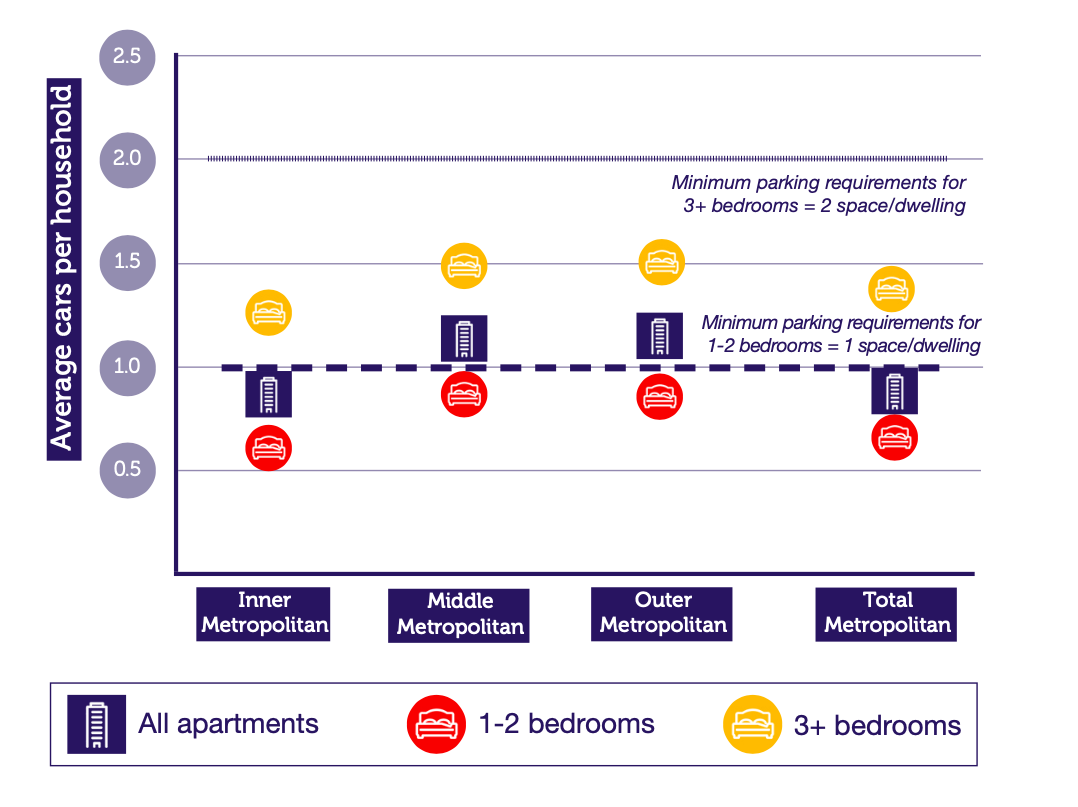New apartments are providing more parking than residents need, leading to smaller and fewer homes for higher prices. RMIT experts discuss how policymakers can get the car parking balance right.
In areas of metropolitan Melbourne with lots of higher-density housing developments, car parking provision is a common cause of local disputes and appeals against planning proposals.
To address these concerns, minimum car parking requirements exist under the Victoria Planning Provisions (VPP) – one parking space for everyone or two-bedroom apartment, two spaces for three or more bedrooms and a visitor space for every five apartments.
But often these standards don’t match resident car ownership and transport demands, leading to inefficient use of land and higher housing prices.
RMIT urban and transport experts break down how policymakers can get the most out of new residential apartment planning and better manage transport impacts that come with new high-density housing across Melbourne.
Understanding what influences car ownership
Car ownership among residents living close to reliable public transport is likely to be much lower than the current VPP car parking requirements.
The VPP allows limited reductions in standard parking requirements, for example in areas within 400m of Melbourne’s high serviced, train, tram and bus routes. Although for residential uses, this reduction is only applied to visitor parking requirements.
But for apartments in areas close to reliable public transport, research indicates lower car ownership is evident of up to a distance of 800m.

Figure 1: Average car ownership by apartment size and region in metropolitan Melbourne (Rose et al., 2017).
Changing patterns of land use, such as being within walking or cycling distance from work and community facilities, can also influence future transport demand.
Providing ‘right-sized’ car and bicycle storage in high-density housing
Access to car and bicycle storage facilities in high-density housing can have a strong influence on travel choices among residents.
By changing the standards from ‘minimum’ to a ‘maximum’, car parking requirements can better accommodate ‘right-sized’ car storage facilities, placing a cap on the number of spaces required.
In London, car parking supply reduced by nearly 40% when requirements changed from a minimum to maximum standard.
Bike storage facilities, which are often undersupplied, should cater for current and future demand and a range of bicycle types like cargo or electric, with at least 50% of spaces ideally provided at ground level.
Set non-car travel targets by building alternative transport infrastructure
Infrastructure for alternative transport modes should aim to provide commuters with easy, reliable and safe access to places of employment, services and recreation.
Ideally, public transport, bicycle and walking infrastructure should be provided before an area undergoes densification so residents can set travel practices before they get used to driving everywhere.
International best practice in higher density development is to aim for at least 80% non-car travel.

Bike storage facilities are often under supplied, but Australia can learn from international best practice in higher density development.
Non-car trips in Greater London are projected to increase from 65% to 80% by 2041 and San Francisco has set a non-car travel target of 80% by 2030, with New York on track to achieve this outcome by 2050.
Australian cities could pursue a similar target, supported by planning for alternative transport modes, such as public transport, cycling and walking around new higher density developments.
This could help alleviate road congestion and improve health outcomes of residents.
Integrate transport infrastructure in new precincts
Victoria’s proposed Suburban Rail Loop will support the development of high-quality residential and mixed-use precincts, improving the liveability of key growth areas by changing the way people move around Melbourne.
The Loop provides an opportunity to rethink how Melbourne’s public transport system supports urban renewal and successful high-density mixed-use precincts, enabling a significant mode shift from cars.
This would not only improve the safety and efficiency of travel throughout the city but also enhance the liveability and sustainability of higher density residential precincts.
The practice policy brief Car Parking Provision for Residential Apartments and critical policy brief Transport Impacts of New High-Density Housing have been written by researchers affiliated with the Urban Futures Enabling Capability Platform, as part of RMIT’s Greener Start Initiative.
Story: Chanel Koeleman





